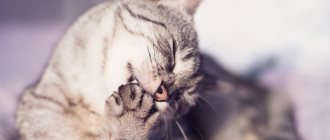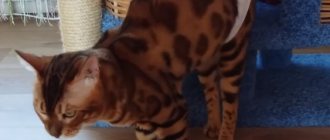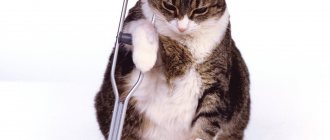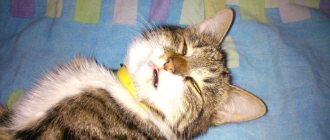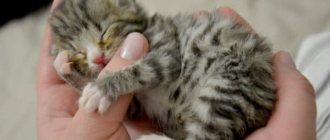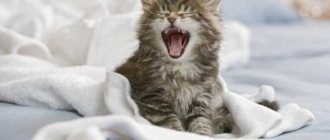If your furry pet licks itself, then you shouldn’t scold it right away. It is important to know that for representatives of the cat family such hygiene is quite normal. Any cat cleans itself, but each one is different in its cleanliness. A rough tongue helps to comb out the undercoat and smooth it, maintaining thermal insulation. Pets do not know how to lower their temperature like humans. They cool the body when they lick themselves. But they don’t always do this just because of their cleanliness. There are situations when this is a necessary measure due to the presence of some disease. Therefore, we will analyze in detail and find out why a cat licks its fur.
The reason for licking is pain
All cats lick their fur. This is normal. With the help of such a simple ritual, they calm down and monitor the condition of the fur coat, removing minor dirt from it and smoothing out protruding hairs. Normally, representatives of this family lick their fur several times a day and wash themselves after sleeping, eating, walking, playing, or contacting other animals and people. At the same time, they behave calmly and relaxed and do not bring the situation to the point of exposing the skin.
The behavior of a pet that spends most of the day licking is abnormal. At the same time, the cat behaves restlessly, and bald patches and even wounds appear on its body (stomach, sides, limbs). If the cat has licked all the fur in certain areas of the body, perhaps he is trying to relieve pain in these places. At the same time, he licks himself on the side where it hurts. Knowing the internal structure of cats, we can roughly guess which organ is suffering.
Is it dangerous?
Frequent licking of a pet's fur should alert the owner. The following symptoms indicate the development of overgrooming:
- the appearance of bald patches in different parts of the body;
- areas with sparse hairs that often break;
- deterioration of the coat condition;
- signs of allergies;
- scratches, ulcers and other wounds on the skin of a cat that take a long time to heal;
- lethargy, apathy and reluctance to eat.
If the problem is neglected, it threatens to affect more areas on the animal’s body.
If you do not carry out treatment in time and do not get rid of the problem in which the cat licks the fur down to the skin, then there is a high probability of multiple bald spots appearing, which will deteriorate the appearance of the pet. When overgrooming, there is a risk of infection in the wounds, as a result of which an acute inflammatory process progresses in the deep structures of the epidermis. When a cat not only injures the skin through frequent licking, but also chews it out in pieces, necrotic lesions appear. Overgrooming is a common cause of disrupted natural hair replacement process.
Prevention means
Only a specialist can cure dangerous licking of a cat’s fur. To protect your pet from overgrooming, you should follow some simple rules for keeping cats:
- try to avoid stressful situations in your pet’s life, and if they arise, use homeopathic sedatives;
- carry out antiparasitic prevention in a timely manner;
- create the right diet and follow it;
- Monitor your pet's health and prevent illness.
Signs of poisoning
The cat, by licking drops of fleas, ensures that insecticides enter the gastrointestinal tract. Therefore, the main symptoms of poisoning manifest themselves from this body system. The most common sign that a cat has licked Bars flea drops or another popular brand is excessive salivation, thirst and loss of appetite. Harmless symptoms disappear spontaneously after a couple of days.
Attention! Drops, once on the mucous membrane of the mouth and esophagus, provoke severe dryness. Hence the animal’s desire to drink a lot of water. Thirst plays into your hands in such a situation; it helps to quickly remove toxins from the body.
For poisoning from flea drops to manifest itself in full force, the animal must swallow almost the entire contents of the bottle or have poor immunity. Signs of severe intoxication:
- vomit;
- diarrhea;
- lethargy and passivity;
- greatly dilated pupils;
- trembling and convulsions.
If a cat has licked off flea drops, it may become very unsteady and skid when running or walking. Before jumping, the animal takes a long time to try it on due to disorientation in space.
Vomit
In addition to poisoning, flea drops sometimes cause an allergic reaction. This usually happens when the dosage is violated or an untested brand of the drug is used. Symptoms of intolerance:
- profuse lacrimation;
- local itching and redness of the skin;
- the appearance of bald spots at the site of application of the medicine.
In these cases, the cause of the symptoms has nothing to do with ingestion of the drops. To eliminate them, the applied composition is washed off, and other lines of products are used to treat fleas.
Skin pathologies (allergies, flea dermatitis, tick-borne infection, etc.)
Flea dermatitis Dermatological problems in cats are usually accompanied by constant itching of the skin. To calm it down, animals lick themselves. Persistent licking often provokes hair loss in the areas being licked. The following skin diseases can lead to this behavior:
- allergies to food, pollen of flowering plants, household chemicals, cosmetics used by the owner, etc.;
- dermatitis caused by fleas;
- infections caused by ectoparasites, such as ticks and lice-eaters;
- diseases caused by fungi.
Worm infestation can also cause compulsive licking. Parasitic diseases are accompanied by itching in the anus. Trying to calm it down, the animal licks this area, as a result of which, over time, bald spots form around the anus. To eliminate this problem, antiparasitic veterinary drugs are used.
To choose a suitable anthelmintic, you need to find out what type of parasites attacked the cat’s body. This can only be done in a veterinary clinic.
Why does a cat lick its fur in different places, but the animal has no fleas?
The presence of fleas in a pet is the first thing a cat owner thinks about if he notices that he is constantly licking his fur. Even if a quick examination did not reveal parasites in the fur, this does not mean that they are not there. Nits are not so clearly visible; they look like black, very small dots on the skin between the hairs.
However, the cause of constant licking of fur can be not only fleas, but also other skin parasites - scabies mites. It is quite easy to identify them by such signs as the presence of lesions on the skin in the area of the ankles, ears and elbows.
If a cat licks its fur mainly in the summer, but does not have fleas or parasites, there is a possibility that the pet has increased sensitivity to insect bites, such as mosquitoes.
Constant licking of a cat's fur in the absence of parasites may be an initial sign of one of the pathological conditions:
- depriving;
- dermatitis;
- endocrine system disorders;
- otitis;
- skin diseases - demodicosis, pyodermatitis.
All these pathologies, in addition to constant licking, are accompanied by other symptoms - the presence of wounds and erosions on the surface of the skin, areas of severe peeling.
Signs of lichen and fungal infections
Infection of the skin with lichen forces cats to clean their toilets more carefully than usual. If the owner notices that his pet has begun to lick its fur most of the time, you need to carefully examine its skin. If there is lichen on the skin, pockets of erosion or scabs will be visible between the hairs.
With fungus everything is much more complicated.
It is impossible to determine the presence of a fungal infection without examination by a veterinarian and instrumental examination using special equipment.
But there are a number of signs that an attentive owner will notice:
- excessive dry skin;
- the skin in certain areas changes its color, becomes paler or, conversely, stands out excessively, becoming darker or brighter by several tones;
- the appearance of gray scales that separate from the skin;
- the fur becomes thinner.
Similar signs may be present in other skin diseases, so it is not possible to make a diagnosis without a veterinarian.
Dermatitis
Identifying dermatitis in a cat is no less difficult a task than diagnosing a fungal infection. A cat will constantly lick its fur because it suffers from an incessant feeling of itching and burning. One of the most pronounced signs of dermatitis is the presence of inflammatory processes on the skin.
It is almost impossible to determine the presence of dermatitis at an early stage of its development, therefore, if the owner notices that his cat has clearly begun to lick itself longer and more often, it should be immediately shown to a veterinarian.
Otitis
An ear infection is always accompanied by severe itching. The cat will lick itself vigorously, damage its face and ears with its claws, and constantly shake its head. Other signs include redness of the inside of the ear, swelling and pus discharge.
Development of skin diseases
Demodecosis and pyodermitis are pathologies of the skin that are accompanied by severe and constant itching, while the cat experiences severe, ongoing discomfort. Due to the incessant “mange”, the cat begins to lick its fur and sometimes does it so intensely that bald patches appear on the fur.
Preventive actions
Fungal and bacterial infections can be prevented by practicing good hygiene. Special medications and treatments will help protect your cat from lichen, dermatitis, otitis media and other diseases. For prevention, you need to regularly treat your pet against fleas, ticks and fungi, and also wash the bowl and tray with disinfectants. Bathing with a special shampoo is beneficial for cats. This procedure only needs to be done once a year.
Important! After treating a kitten with anti-flea or anti-fungal products, the animal should not be bathed. It is forbidden to wet the area where the medicine was applied.
The cat licks itself to help itself
Sanitizing the tray and bowl
All items belonging to the cat - bowl, tray, toys, etc. - must be regularly washed and treated with disinfectants. This will protect your pet from infectious, fungal, viral and other diseases. The bowl can be washed with regular dishwashing detergent. Usually fungus does not form on a cat's bowl, most often in the tray. It is advisable to treat it with any antifungal spray against lichen. Additionally, you can treat the tray with camphor alcohol, which not only cleans and disinfects the surface, but also eliminates unpleasant odors.
The bowl and tray should be washed and disinfected regularly
Special flea products
There are many treatments available at pet stores for fleas and other external parasites. They are available in the form of drops on the withers, sprays and collars. It is advisable to treat the cat with drops on the withers; this is the most effective remedy. The room can be sprayed with flea spray. Flea collars are not very effective. It does not destroy insects, but only repels them. A collar can only be put on a cat if it has recently been treated for fleas. Flea drops such as Leopard, Frontline, Advantage, Inspector, and Bolfo spray are very effective.
Flea remedies
How to help a cat
To help your cat, you need to determine the root cause of the behavioral problem. If the cause lies in diseases, the veterinarian will prescribe symptomatic therapy using medications for general and local treatment.
It is equally important to eliminate the factors that aggravate the problem. Review the cat's diet, create optimal living conditions for the pet, and protect the cat from stress.
After treatment, you need to take your cat to the clinic several times a year for a comprehensive examination. If overgrooming is caused by chronic pathologies, relapses are possible.
Vitamin and mineral preparations, food additives, and animal shampoos that have an antiseptic and anti-inflammatory effect will help restore the coat.
Are you faced with the fact that your cat licks its fur down to its skin and you don’t know how to treat it? First, you need to establish the exact cause of the abnormal behavior that appears, because this is what further actions will depend on. In some cases, long-term and painstaking treatment will be required, and in others, improvement of living conditions. An experienced veterinarian will help you deal with the problem.
The desire to cleanse itself as a reaction to foreign odors on the fur
Cats are very clean creatures. In addition, they have an excellent sense of smell, thanks to which they are able to sense even subtle odors. If the pet feels that its fur smells of something, it will begin to lick it until it completely gets rid of it. Sometimes this desire leads to bald spots appearing on the body of an animal that washes itself too zealously.
Have you noticed that the cat licks its fur in an unusual way?
Sometimes the normal process of grooming becomes obsessive. This excessive licking is a signal that there is a problem.
If your cat licks its fur too often or for too long, do not ignore this fact. A cat can lick itself to such an extent that there is no hair left on the skin. Usually, owners notice that the cat licks its fur too often when bald spots appear on the stomach and other easily accessible places on the body. One sign of excessive licking is frequent regurgitation of hairballs. This means it's time to stop observing and start taking action. What to do if you decide that your cat pays more attention to licking its fur than necessary?
According to Doctor of Veterinary Medicine (DVM) Pamela Perry of the Animal Behavior Clinic at Cornell University, the average cat spends 30 to 50 percent of its grooming time grooming. This is quite a lot, so owners do not pay attention to the problem until they notice significant hair loss or even skin damage.
How to prevent a bad habit
The fact that an animal licks itself non-stop after sterilization is a normal, understandable phenomenon. After surgery, when the incision scar begins to heal, this process is accompanied by severe itching and burning. It is not surprising that the cat will try to relieve discomfort by constantly licking the skin.
But it is important for the owner to understand what this can lead to. If the suture is constantly wet after surgery, this will lead to poor and too slow healing and increase the risk of secondary infection.
Constant licking of fur is always associated with the fact that the cat develops itching of various etiologies on the skin. Its occurrence can be prevented by taking preventive measures:
- The good health of a pet depends primarily on its owner, who must regularly sanitize the cat's litter box and food bowls.
- Don’t forget about antiseptic treatment of pussy ears using special products. This way you can prevent the appearance of lichen and fungal infections.
- To prevent fleas from appearing, the cat needs to be bathed regularly, the fur must be treated with special preparations, and a special flea collar must be put on the pet.
- It is recommended to carefully approach the issue of choosing industrial food and natural products so that your pet does not develop allergies.
- You can prevent excessive dryness of the skin and its peeling, which is why the cat begins to constantly lick itself, by choosing the right hygiene products for bathing - they should be specialized, in no case human or even children's.
READ What to do if your cat only eats dry food and is it dangerous?
Reasons why a cat licks a person's hand and face
Animals express emotions and feelings in their own way. Often, feeling affection, they lick people and can lick gently. Although there may be other reasons for what is happening. Let's look at them in detail.
Many cats consider licking their owners a mandatory ritual.
Expression of affection
When expressing their affection, cats rarely lick a person. This is most often the prerogative of dogs. But sometimes they can lick the owner's face or hand. And this will be a short-lived act.
To express tender feelings towards a person, cats use other methods:
- they purr gently;
- They cuddle up to their owner's hands so that he can stroke them.
Maternal care
During the period of motherhood, it is typical for cats to care for and show tender feelings towards their offspring.
When a female reaches puberty and her body becomes ready for reproduction, hormonal imbalance may occur.
The pet, having not received what it wants, feels discomfort. And against the backdrop of what is happening, he tries to express emotions in any way possible.
If this is attachment to the owner, then he will become the object of her courtship and care. There is a false manifestation of parental instincts.
Therefore, it is recommended to sterilize animals before they are one year old, so as not to torture them.
Begging
If a pet licks a person's hands, especially the palms, this is an indication of begging. Practice shows that a kitten that was raised by artificial feeding will definitely lick the back of the owner’s hand if it wants a tasty snack.
If we are talking about same-sex cats or relatives, joint licking indicates a close moral connection
Boredom
If your pet is not given enough attention, it may lick itself out of boredom. Most cats, of course, resort to gluttony. But active licking also occupies a special place in this rating.
If the problem is not corrected in time, the pet will cause significant damage to its health. Because the wounds will not have time to heal.
And from the point of view of the physical state of health, this will be regarded as a pathology.
Strong smell
In nature, pungent odor is a significant problem for animals. Because predators have a greater chance of catching such a smelly fish. If a person came after a run or just from work, and the cat began to actively lick him. This indicates that he does not smell very good.
The poor animal, trying to protect him, tries to wash his owner and hide him from his enemies.
Self-assertion
For hierarchical reasons, the elders in the pack can express their condescension by licking other relatives. In this case, this is not a manifestation of tender feelings, but a favor. The same applies to the situation with a person. There is no difference if we are talking about a dominant pet.
There is no need to be afraid or afraid of such licking, unless there are aggressive attacks.
What to do if a cat licks itself until it has bald patches and wounds?
The most reasonable solution in this situation is to show your four-legged pet to a veterinarian. An attempt to help a pet on your own is fraught with serious consequences for its health, since it is impossible to determine at home what exactly led to such unusual behavior of the animal.
The veterinarian will prescribe an examination for the four-legged patient and identify the cause of persistent licking, accompanied by exposure of the skin and the appearance of wounds on it. If parasites are the culprit of the cat’s behavior, she will be prescribed antiparasitic veterinary medications. If it turns out that the source of the problem is a malfunction of any internal organ, the cat will be prescribed appropriate treatment.
It is not always necessary to treat a pet that licks its skin to bald spots. Sometimes it’s enough to simply calm him down by creating a calm atmosphere in the house, or give him a bath if he thinks his fur smells of something unpleasant. In the latter case, you need to use zoo shampoos - they do not contain fragrances.
Is licking owners dangerous?
If the animal is healthy, then there is no danger for humans in licking it. Moreover, animal psychologists do not advise rejecting your pet at this moment, even if it is unpleasant for you.
Licking serves as a basic means of communication
Some even believe that cats sense their owner’s sore spots and heal them with their energy by licking him.
The behavior of pets can be studied over a long period of time. Some lick themselves right down to their bald patches, causing damage to their health. Others may lick people to show their feelings.
In any case, it is worth understanding that licking itself is a problem.
We need to fight it. Whereas such a procedure will not bring danger to humans. This is provided that the pet is absolutely healthy.
Cornell Feline Health Center. Cats That Lick Too Much (March 29, 2006)
Diagnostic measures
- Complete blood count, biochemical blood test and urinalysis.
- Bacterial culture of urine to exclude urinary tract infection
- Cytology and bacterial studies
- Coagulation in cases of bloody discharge and/or coagulation disorders
- X-ray of the abdominal cavity, to detect inflammation of the uterus in intact (not spayed) females or prostate disorders in males
- Abdominal ultrasound
Constant licking of fur is an alarming symptom, indicating that pathological processes are occurring in the animal’s body, often associated with mental instability and severe stress. Therefore, it is recommended to immediately take the cat to the veterinarian to identify the causes of this phenomenon and make an accurate diagnosis.
The veterinarian will conduct a visual examination of the animal and prescribe a number of laboratory tests. If dermatitis, fungal infection or infectious skin diseases are suspected, a bacteriological culture from the affected area is taken. If the doctor suspects that the cat has problems with the functioning of the endocrine system, it will be necessary to take a blood test for hormones.
A cat constantly licks its tail
If a cat often licks under its tail, this should alert the owner. Various reasons force males and females to lick this place.
If a cat often licks its tail, then this is:
- inflammation of the preputial sac;
- inflammation, injury or cancer of the foreskin;
- urethral diseases (stones, trauma, neoplasm);
- bladder diseases (infections, tumors, stones);
If a cat constantly licks itself, then this should alert the owner
- prostate diseases (prostatitis, tumor, abscess);
- urinary incontinence;
- dysfunction of the sphincter;
- bleeding (coagulopathy) and thrombocytopenia due to rat poison poisoning.
For your information! Cats have a fatty lubricant in their skin that contains cholesterol, which in the sun is converted into vitamin D. By licking, the cat distributes this substance over the entire surface of the body.
Females often lick themselves before and after childbirth, and this is not a pathology. But there are a number of situations where excessive licking is a symptom of illness.
If a cat constantly licks its tail, then this is:
- urinary tract infections;
- inflammation of the uterus and vaginitis;
- tumors of the genitourinary system;
- injury or foreign body in the urinary tract or vagina;
- blood clotting (coagulation) and thrombocytopenia in case of poisoning with rat poison;
- urinary incontinence, sphincter dysfunction;
- retained placenta or death of the kitten during childbirth.
Important! If a cat constantly licks the area near the tail, then the owner needs to pay attention to the discharge from the pet’s genitals. These symptoms will help the veterinarian make the correct diagnosis and treat your pet.
If your cat is constantly licking his tail, you need to take a closer look at other symptoms.
Allergic reactions to foods
The most common cause of itching and skin irritation in cats is food allergies. A cat can become ill from both natural food (for example, meat) and special industrial ones. Popular cheap foods (Kitecat, Whiskas, etc.) cause allergies in many people. It is advisable to choose premium hypoallergenic ones, which are sold only in pet stores.
For your information! Most often, allergies are caused by food proteins, which are found in large quantities in chicken meat, cow's milk and a number of other products.
If a veterinarian has discovered a food allergy in a cat, you need to exclude the dangerous product from the diet and prescribe the correct diet for your pet.
A cat food allergy often manifests itself as inflammation on the skin.
Presence of parasites in the body
External and internal parasites often cause cats to scratch and lick themselves. Fleas, ticks, and lice eaters are especially dangerous for furry pets. They bite the cat and drink its blood, and this leads to the development of allergies and decreased immunity. Ear mites often cause otitis media, a serious disease that can lead to serious complications.
If a cat has parasites in its fur, it will lick them frequently and feverishly. Small blood-sucking insects greatly irritate your pet's delicate skin. Parasites can be easily removed with flea treatment, but you should consult your veterinarian and check your cat for other diseases.
Flea dermatitis
Damage to the skin on the tail
Any owner knows why cats lick themselves. If your cat's tail has wounds or any other damage, it can cause itching and irritation. Having received an injury, the cat begins to lick the sore spot in order to heal it. This way the animals lick any sores. To prevent your cat from doing this, you can put an Elizabethan collar on it.
Unpleasant habit after castration
A situation often arises when a cat licks itself after castration. Every veterinarian knows what to do in this case. He must examine the pet and check for allergies, infections and inflammatory processes.
But is it possible for a cat to lick itself after castration, the answer will be clear - it’s impossible, because the pet can lick the post-operative suture and cause an infection. If the owner overlooked it, and after castration the cat licked a wound under its tail, this requires urgent treatment and re-suturing. To prevent this from happening, a medical collar is put on the cat, which must be worn for 10 days after the operation. The suture should be treated with special medications prescribed by a doctor.
Important! Sterilization is a necessary procedure, but it must be carried out strictly following the rules of hygiene and antiseptics.
After castration, the cat must be wearing an Elizabethan collar.
Treatment of overgrooming in cats
Overgrooming is excessive licking of an animal, which leads to the formation of areas with broken or sparse hair. Sometimes real bald patches appear, where the villi are completely absent.
To prescribe effective treatment, it is recommended to consult a veterinarian.
After an external examination and, if necessary, laboratory tests, it is important to identify the true reason why he is ready to lick. And from this we consider the direction of therapeutic treatment.
How to protect an animal from poisoning?
Treating a cat with anti-parasite drops is a responsible undertaking. Although the concentration of chemicals in the drug is considered relatively harmless to the animal, ingestion of the flea agent should be avoided at all costs. Proper application plus compliance with safety precautions is a reliable guarantee of your pet’s health.
For mild infections or for prevention, veterinarians advise using natural essential oils. The scents of tangerine and anise repel fleas. If they are applied to the cat's withers, the parasites will not bother her.
Problems not related to diseases
In some cases, excessive licking is not associated with any health problems. It can be triggered by a variety of reasons, among which the most common are:
- Stressful situations cause nervous tension, but in this case the cat’s behavior also changes. Her tail is shaking, she is constantly shaking, her pupils are greatly dilated. Such conditions occur when moving, a sudden change in environment, or aggressive behavior of other animals or owners.
- The desire to eliminate a foreign odor, which can most often be noticed after a cat has been stroked by a stranger or after returning from a street walk.
- Fear of enclosed spaces, oddly enough, but being in a closed room for a long time has a negative effect on the animal’s psyche. In this position, it can lick itself until serious wounds form.
- Active cleansing in the tail area during female estrus, which is a desire to clean up.
All pathological conditions must be monitored and the pet must not be neglected. Frequent and prolonged licking quickly leads to addiction, which is called overgrooming. This is a mental disorder that is most often detected in purebred cats, but it is often detected in ordinary pets.
